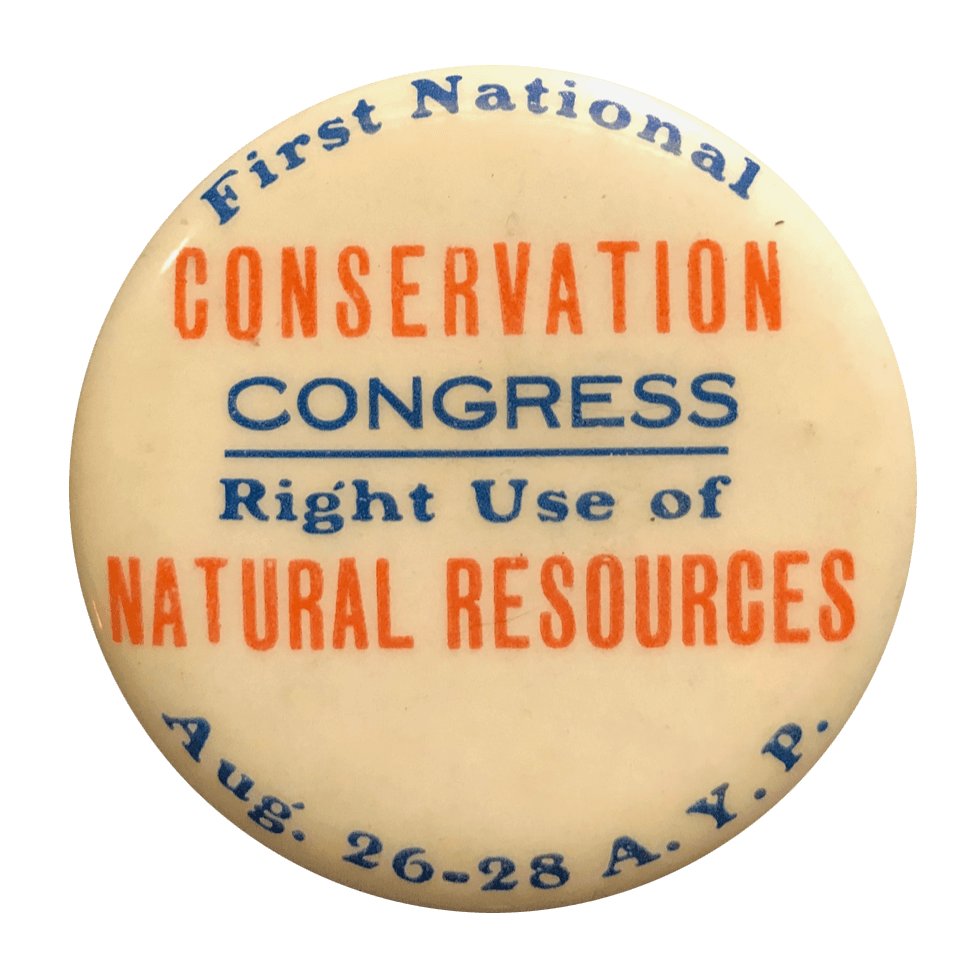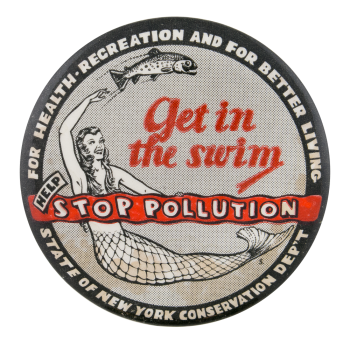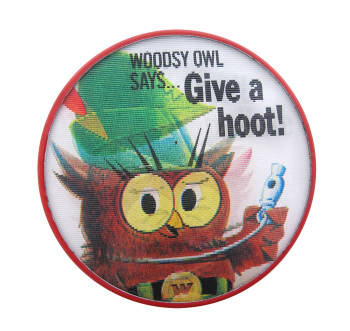In 1969, the Environmental Action for Survival Committee at the University of Michigan started selling pinback buttons with the slogan “Give Earth a Chance,” a play on the popular anti-war slogan “Give Peace a Chance.” Newsweeks’ 1970 article, “The Ravaged Environment” noted the popularity of these buttons, suggesting they were the symbol of the Age of Conservation. These buttons, alongside buttons featuring the ecology symbol, the peace symbol, and more, reflected the solidarity of the 20 million demonstrators during the first Earth Day march on April 22, 1970.

Ecology is the study of the interrelations among and between organisms and all aspects of life and the environment. Environmentalism is an ideology and social movement concerned with protecting the health of the environment, it builds on the interconnections studied in ecology. While the 1970s counterculture is most commonly associated with environment and ecology movements, you can trace their beginnings back to the cultural movement in England called Romanticism (1780-1830). This movement focused on the poor conditions of workers, new class conflicts, and the pollution of the environment, leading to a reaction against urbanization and industrialization as well as a new emphasis on beauty and the value of nature. During the Romantic Era, human effects on nature were becoming readily apparent through deforestation and pollution and the literature created by writers such as Wordsworth, Coleridge, and Shelley opposed Industrialism by highlighting the interconnectedness of man and nature and predicting the destruction of Earth.
This environmentalist sentiment continued into the 19th century as Industrialism expanded. Groups like the Sierra Club, founded in 1872 by John Muir, aimed to ensure the conservation of nature. Pollution caused by industry was a major issue going into the 20th century, which led to the formation of various conservation groups in America. One of the earliest ecology pinback buttons was created by the Washington (State) Conservation Association in 1909 to commemorate the First National Conservation Congress. These congresses began as a response to the 1908 Governors' Conference on the Conservation of Natural Resources, an event that placed conservation at the forefront of public consciousness. Until 1915, these congresses were the singular meeting place for government and private conservation organizations and featured discussions and debates about conservation efforts being made in the United States. As the first conservation congress established in the United States, private conservation groups were able to connect with each other and discuss the development of conservation work in the country.

Environmentalism remained steady through-out the decades, and by the 1950s, water pollution was a big topic. Significant efforts were led by the League of Women Voters in 1956 to make water pollution a focus of education and activism, with many local chapters leading clean-water campaigns in their communities. An early ecology button created by the State of New York Conservation Department (1926-1970) features a mermaid and a fish, as well as the slogan “Get in the swim, help stop pollution.” This button was made in the 1950s and, at that time, the term “pollution” was not commonly used in reference to man’s impact on the environment. As awareness of pollution increased, the word was used more and more.

As discussed above, the 1960s and 1970s saw a rise in environmentalist activity, as well as an increase in ecology buttons. In 1966, while on an LSD trip in San Francisco, Stewart Brand believed he could see the curvature of the earth and had the idea that if the world could see that Earth was spherical and finite, and treat it as finite, civilization would progress in the right direction. The next day he started printing up his “Why haven’t we seen a photograph of the whole Earth yet?” pinback buttons, which would go on inspire his Whole Earth Catalog, a publication that aimed, in a nod to ecology, to interconnect counterculture and scientific communities.


In 1970, Greenpeace, an international, non-government environmental organization, began using pinback buttons as a form of advocacy and, in order to raise funds, they began selling them for 15 cents each. These buttons were designed by art student Paul Nonnast and feature a bright yellow background with “Greenpeace” in the middle, a green peace sign below, and a green ecology symbol above. The ecology symbol included on the button is a 1969 design by Ron Cobb which combines the “e” from ecology and the “o” from organism and has been used as a symbol for Earth Day and other environmental causes. Because of the size of the buttons, they struggled to add a space between the words “green” and “peace” ultimately deciding to combine the words and renaming themselves into one word “Greenpeace.”
Pinback buttons have also been a popular way to advertise conservation mascots and slogans. The U.S. Forest Service has two well beloved mascots that have been featured on numerous buttons throughout the decades. The first, Smokey Bear, was created in 1944 by artist Albert Staehle with the original catchphrase "Smokey Says – Care Will Prevent 9 out of 10 Forest Fires." In 1947, in partnership with the Wartime Advertising Council (later the Ad Council), Smokey’s slogan was updated to its most iconic form, “Remember … Only YOU Can Prevent Forest Fires,” remaining the slogan for over five decades. As of 2001, the slogan was updated to its current iteration “Only You Can Prevent Wildfires” in responses to a massive outbreak of wildfires in areas other than forests. The choice to use “wildfires” over “forest fires” signifies Smokey’s prevention of unwanted and unplanned fires rather than planned, controlled burns. Another mascot, Woodsy the Owl, was created in 1971 with the original motto “Give a Hoot; Don’t Pollute.” Woodsy has been an advocate to encourage children to become invested in caring for the environment. Both these characters have been featured on pinback buttons in various iterations.


April 22, 2020 marks the 50th anniversary of the first Earth Day demonstrations. These original demonstrations placed the environmental movement into the forefront of American minds, highlighting the ever-increasing human activity affecting the earth. Pinback buttons for various environmental causes have functioned as a focal point for ideas and themes, allowing like-minded individuals to quickly recognize each other and further discuss these causes as well as facilitate discussions with those who are curious. Fifty years later, and with the current discussions around climate change, it seems likely that pinback buttons will continue to serve the environmentalist cause as points of discussion.
References
Brand, S. (2008, May 30). Photography changes our relationship to our planet. Retrieved from https://web.archive.org/web/20080530221651/http://click.si.edu/Story.as…
Dr. Seuss designed rare "I speak for the trees" ecology-themed button featuring the Lorax. (n.d.). Retrieved from https://www.hakes.com/Auction/ItemDetail/79599/DR-SEUSS-DESIGNED-RARE-I…
Give earth a chance: Environmental activism in Michigan. (n.d.). Retrieved from http://michiganintheworld.history.lsa.umich.edu/environmentalism/
Lallier, A. (n.d.). Environmentalism and British Romanticism. Retrieved from http://web.utk.edu/~gerard/romanticpolitics/ecology
Library of Congress. (n.d.). Documentary chronology of selected events in the development of the American Conservation Movement, 1847-1920. Retrieved from https://memory.loc.gov/ammem/amrvhtml/cnchron5.html
Morton, T. (2005). Environmentalism. In N. Roe (Ed.), Romanticism: An Oxford Guide. Retrieved from https://www.academia.edu/1084448/Environmentalism
Rome, A. (2003). "Give Earth a Chance": The environmental movement and the sixties. Journal of American History, 90(2), 525–554. doi: 10.2307/3659443
Seed, M. (n.d.). History of the Greenpeace button: Material objects as vehicles of advocacy: VMM. Retrieved from https://www.vancouvermaritimemuseum.com/blog/history-greenpeace-button-…
Sierra Club. (n.d.). About the Sierra Club. Retrieved from https://www.sierraclub.org/about-sierra-club
The Ad Council. (n.d.). About the Campaign. Retrieved from https://smokeybear.com/en/smokeys-history/about-the-campaign
Turner, F. (2008). From counterculture to cyberculture: Stewart Brand, the Whole Earth Network, and the rise of digital utopianism. Chicago, Ill: University of Chicago Press.
U.S. Forest Service. (n.d.). A short history. Retrieved from https://www.fs.usda.gov/Internet/FSE_DOCUMENTS/stelprdb5193740.pdf
US Forest Service. (n.d.). The story of Smokey Bear: US Forest Service. Retrieved from https://www.fs.usda.gov/features/story-smokey-bear
U.S. Forest Service. (n.d.). Woodsy Owl. Retrieved from https://www.fs.usda.gov/learn/kids/woodsy-owl
Research and text by Chelsea Clark
